So that’s it for our year at the Highland Folk Museum! To round up our project, here are some stats:
- We exceeded the amount of objects that was originally planned (535). We documented, researched and conserved a total of 564 objects, (which equates to 628 records on the AdLib database, taking in to account object parts).
- Over the course of the project we have taken, edited and uploaded 2806 photos of the collection.
- We have written 19 blog posts about our project, which have reached almost 60,000 people on Facebook, with over 1300 comments and shares, and 2500 post clicks.
- We have run three very successful events, which have directly reached 98 people through our Behind the Scenes day, Best Practice training day and the HFM annual seminar.
- 46 items have been treated for pest problems including 23 frozen for woodworm and 23 treated for mould.
- 42 custom Correx boxes have been made to house vulnerable or fragile objects.
A Barvas success
If you’ve read our blogs for a while you may remember that Helen and I recently couriered a group of basketry and rope work objects to An Lanntair, an arts venue in Stornoway. Whilst in Lewis we couldn’t resist visiting Barvas, the small village where Barvas ware was made and see for ourselves where this part of the collection originated, as well as see if we could get our hands on some Lewisian clay. We met up with Sue Blair at the Borgh pottery which is just outside Barvas (1), for a cup of tea and a chat about Barvas ware. Sue has previously made replica craggans for Stornoway Museum and was impressed even by our fragmented first Barvas attempts. Then we headed in to Barvas itself. There are some historical accounts of where clay can be found in Barvas, the most detailed of which comes from an interview between Prof Hugh Cheap of UHI and Mr Malcolm MacIver, who lived in Barvas (2). They discuss that they used to dig the clay on the crofts in Park, Barvas alongside the river in two or three places, as well as in an area of Lower Barvas which is now covered over with rubble from a nearby building site. We drove along Park and at the very top found a bend in the river which had cut a couple of metres of the river bank away, revealing a layer of clay.
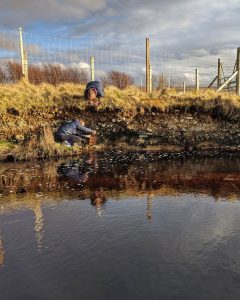
Digging for clay
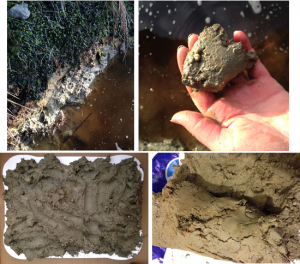
Top left, the clay at the river bank, top right how it looked before processing.
Bottom left, drying the clay on a plaster bat and bottom right, wedging the clay
Once we had dug our clay the next step was to process it. To do this Helen picked out all of the stones and dried it on a plaster bat (or board) until it contained the right level of moisture, and it was then wedged or kneaded just like dough, to make the clay more ‘plastic’ and workable. Our previous attempts at firing had shown us that the most successful technique was to place the vessels in to a cooler peat fire and leave them overnight, which proved once again to be successful. Although two of our vessels appear low fired, possibly because they were at the bottom and didn’t get hot enough, our sugar bowl and teapot came out of the fire in one piece and the milk glaze was a success. Once fired these pieces looked very similar in colour and texture to the originals, although we haven’t quite perfected the Barvas style!
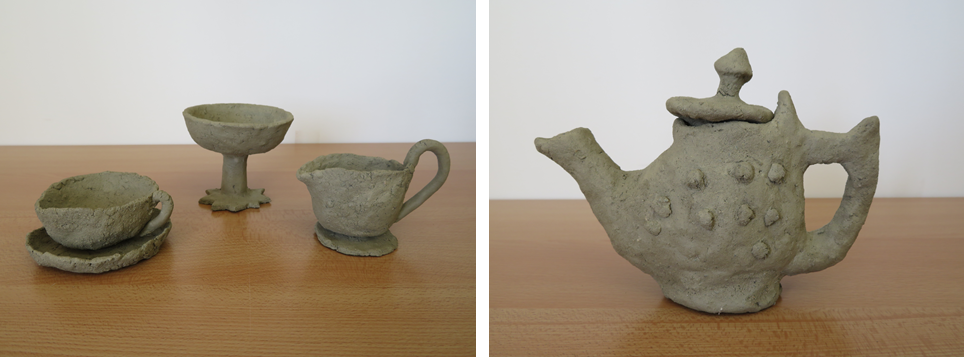
Our imitation Barvas ware before firing
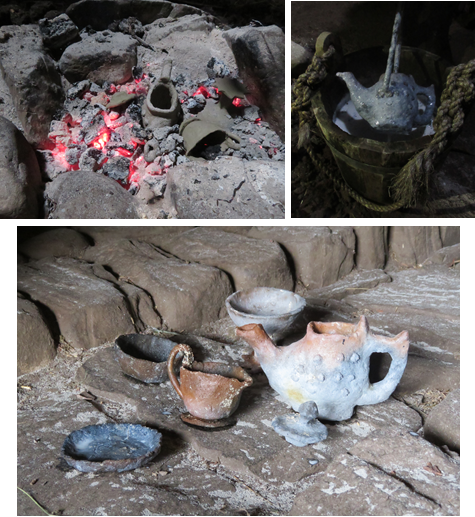
Firing the Barvas
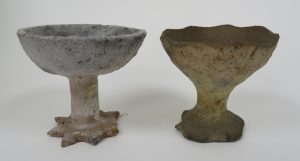
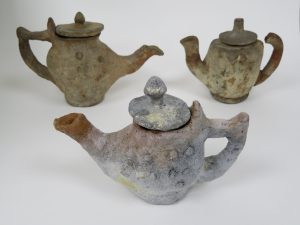
Our pieces after firing, with their original counterparts
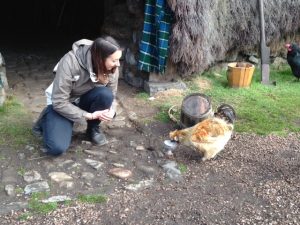
Helen feeding a chicken out of an imitation Barvas style sugar bowl
Taking the pots out of the fire on our last day working at the folk museum was a fitting end, and a great way to round off the year. It has been a total pleasure to get to know the collection and to improve the documentation and storage of a wide variety of objects, securing them for future generations of museum visitors and researchers. We hope that I.F. Grant would be appreciative and proud of our efforts!
An unexpected but wonderful legacy of our project is that staff members from An Lanntair who run the Arora dementia project will soon be including Barvas ware in their creative making sessions. People living with dementia across the Hebrides will be able to try out this vernacular craft, and perhaps there will be some memories reignited and shared about its history and its role in the local area.
Thank you for reading our blog posts and keeping track of what we’ve been up to! Come and visit the museum if you can – if you’re here on a Tuesday afternoon you can come along to a store tour, and get to see inside the wonderful store that we’ve been working in. You might just recognise some of the objects…
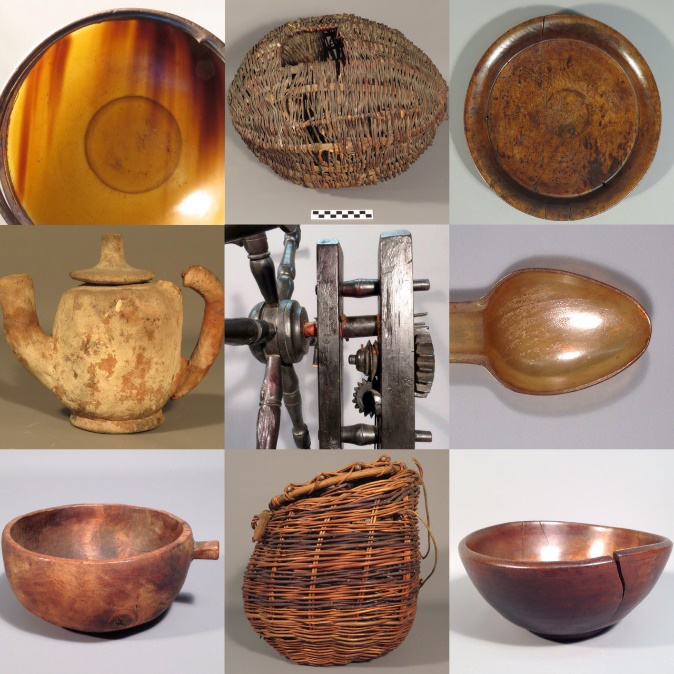
Some of Helen’s favourite objects.
Top L-R: a translucent horn bowl; a wool basket or mudag; a centuries old scratched and worn wooden plate.
Middle L-R: a Barvas teapot; the workings of a jack reel; a horn spoon with initial carved into the bowl.
Bottom L-R: a rustic quaich with one small lug; a lovely shaped angling basket; a smooth, old wooden bowl with a beautiful patina.
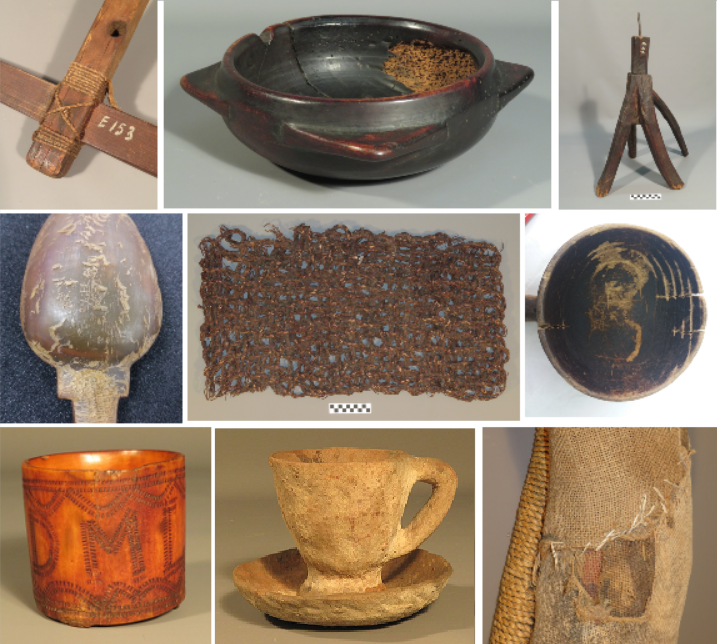
Some of Rachael’s favourite objects:
Top, L-R: A repaired crois iarna, a quaich badly damaged by woodworm, and a wool winder made using the fork of a tree.
Middle, L-R: A scaling horn spoon, a heather mat and a badly burnt ladle.
Bottom, L-R: A horn beaker, a Barvas ware cup and saucer and a repaired woven straw horse collar.
Rachael and Helen
(1) http://www.borghpottery.co.uk
(2) Interview between Prof Hugh Cheap and Malcolm MacIver on the subject of Crogans and Barvas pottery, 31st May 1988.
Previous blog post – Make do and mend

